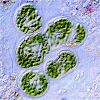Rapeseed, avocado, oil tree are being used to produce oil and the oil and fat extracted from these plants is used by human beings. It is very common ability of most plants to produce oil by using carbon dioxide and water in presence of sunlight. Many small and large plants produce oil by this methods it includes unicellular algae as well as giant sequoia trees. Scientists come across to know it for the first time that Cyanobacteria also have this ability and these can also produce oil by using carbon dioxide and water. A professor in the university of Bonn from institute of molecular physiology and biotechnology explains that this is a huge surprise for the scientists of the whole world.
Cyanobacteria are also called blue green algae. These Cyanobacteria are able to produce oil from water and carbon dioxide in the presence of light. Until now it was assumed that the ability to produce oil was only the gift of nature for plants and it was also assumed that blue green algae or Cyanobacteria cannot produce oil.
But that was the assumption of yesterday , today we are living in a life of innovation, a life of biotechnology and a life of molecular biology. It’s a practical era of life. One aspect in the whole scenario is very interesting that blue green algae will attract the suppliers of oil and food because of its ability to grow without arable land.
The name blue green algae makes a sense that it is a name of algae but it is not true. Blue green algae are actually bacteria also named as Cyanobacteria. Therefore these are different from plants in many aspects. These are close relative to the bacteria found in the intestine instead of their resemblance with olive tree. In past it was assumed that the Cyanobacteria can produce oil but it was just a theory no body can prove it.
From last many years scientists were working on the activity of an enzyme which is involved in a step of oil synthesising process in plants. This enzyme is activated in chloroplasts to produce oil. Chloroplast is actually a plant cell organelle mainly involved in photosynthesis. Thanks to these chloroplasts that these produce energy rich compound for us by the process of photosynthesis in the presence of light.
Origin of chloroplasts
Scientists have been giving theories about the origin of life on earth and all the theories regarding origin of life on earth say that life on earth started from single cell organisms such as bacteria and Cyanobacteria. Some theories say that chloroplasts were individual organisms in the starting of their life and later they entered into bacterial cell and became an organelle of the cell. Further the theories say that a Cyanobacteria having chloroplasts in it were swallowed by plants and these chloroplasts of Cyanobacteria started photosynthesis in plants. If these theories and hypothesis are true then the oil synthesis enzymes of chloroplasts is may be originated from Cyanobacteria.
Oil synthesis enzyme similar to that of plants
As we know that scientists have know the genome of various organisms now a days. The genes which code the oil producing enzymes in plants were also decoded and scientists started search of similar sequence of DNA in Cyanobacteria. In this regard they started to study genome of various Cyanobacteria. After a time their efforts brought fruits and they found that gene in Cyanobacteria or blue green algae named as acyltransferase. Plant enzyme involved in oil production also belongs to this group. After knowing this evidence scientists move forward to a next step and they come to know that Cyanobacteria actually produce oil with that particular enzymes however the quantity of oil produced by blue green algae is in small quantity.
 |
| Blue green algae at oceans |
This result is very interesting for scientists as it opens the doors of further researches and to use Cyanobacteria as a source of food of. Various animals and also biofuels. The positive aspect of Cyanobacteria at this era of time is that they do t require a land field to grow but they can grow in a culture media having sufficient light and heat.
Blue green algae reduce green house gases
The simple lifestyles of blue green algae may allow them to grow in the deserts and in this way these would provide oil for cars in the deserts. The oil producing Cyanobacteria also contribute in cleaning the climate by absorbing carbon dioxide. Cyanobacteria found on oceans bind with green house gases and reduce their quantity in the atmosphere. According to an estimate, if blue green algae don’t contribute in reducing carbon dioxide then the quantity of carbon dioxide will be doubled in the air which is a big threat.
The scientists say that the blue green algae species which are under their studies produced a small amount of oil but it is possible others may produce more oil quantities. Another good thing is that these Cyanobacteria can easily be genetically modified by genetic engineering to produce high oil yielding Cyanobacteria. They hope that they will give much better results in upcoming days.






0 Comments
Please don’t enter any spam link in the comment section.